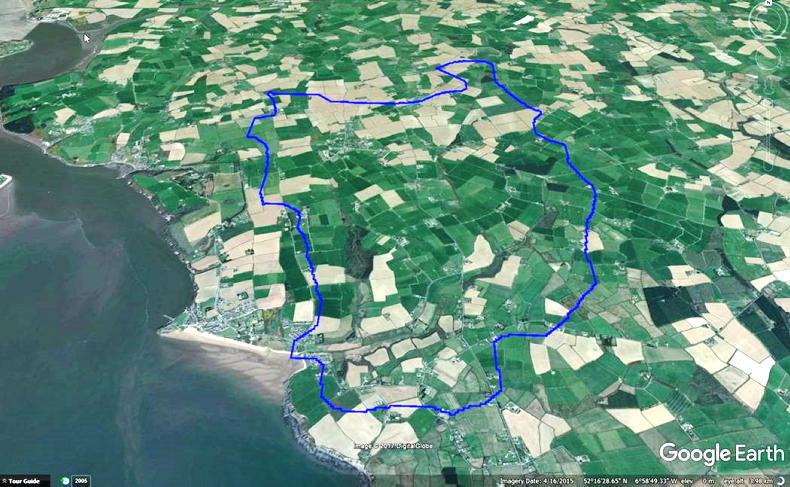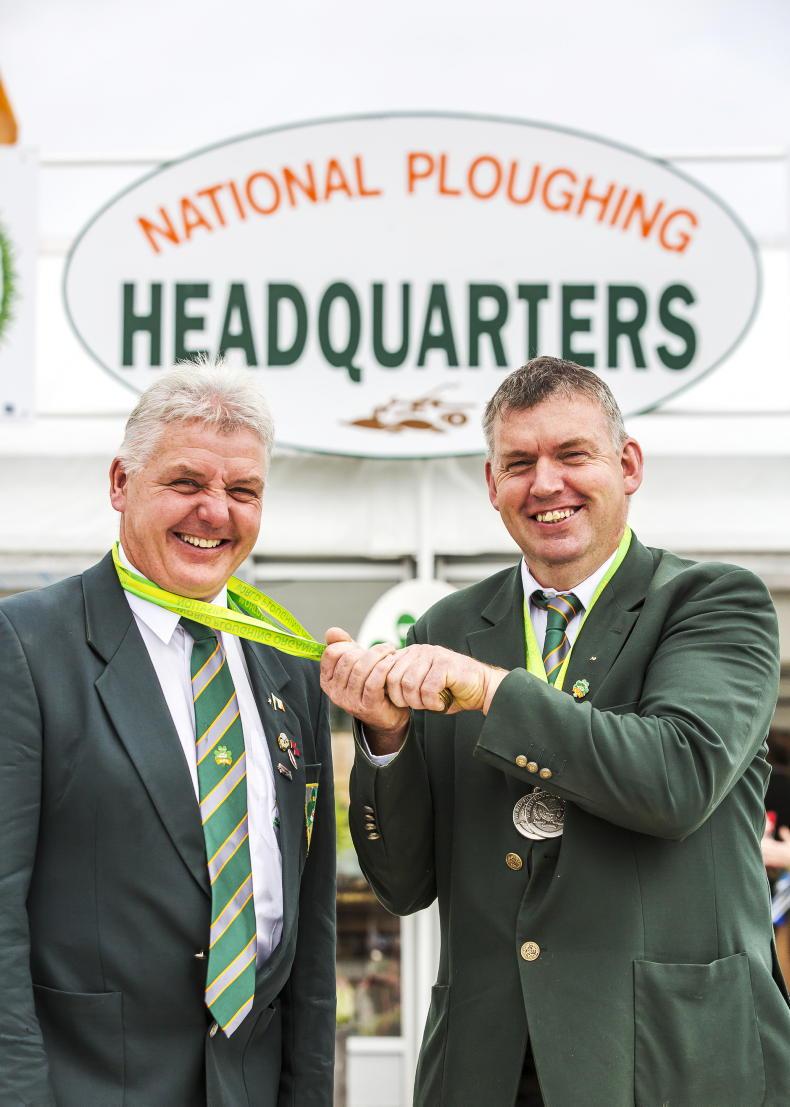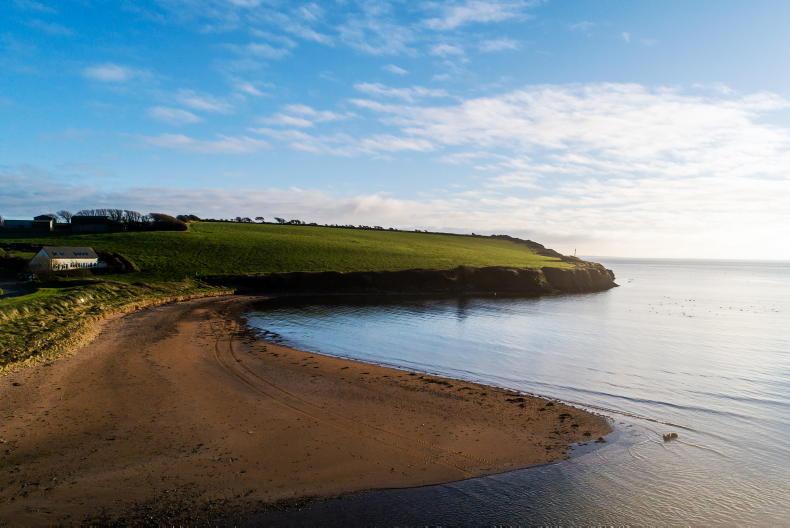Thirty-six farmers in Wexford are being paid up to €4,000 for carrying out actions which improve the water quality of two streams which flow out to sea at Duncannon beach in Co Wexford.
They are taking part in the Duncannon Blue Flag Farming and Communities Scheme EIP, a €550,000 scheme which began in 2018 and will end in 2021.
Each farmer in the scheme is given a specific pollution potential zone (PPZ) plan of their farm and is assigned a project manager, who goes through the plan with the farmer and looks at what measures can be put in place to improve water quality.
The plan covers slurry, farmyard manure storage, soiled water, roadways, land management and watercourses and points to areas where farmers can reduce run-off.
Project manager Eoin Kinsella told the Irish Farmers Journal that some farmers in the catchment may not need to do anything.
“It all comes down to his or her individual PPZ plan and once that is carried out, it could be a minor job such as following nutrient management plan maps more accurately or simple advice like applying lime to fields.
“Each farmer was given a baseline PPZ plan earlier in 2019, which gave them all some time to carry out works. Some farmers have the works completed at this stage and others are starting,” he said.
Actions and payment
Actions completed and ongoing by farmers include the fencing of watercourses 1.5m from the top of the bank to the river to protect them from cattle and the establishment of arable grass margins, either 3m, 4m or 5m in width.
“We also have farmers relocating water troughs away from watercourses. Other actions the project are looking at the plantation of willow along river banks and the planting of hedgerows where there is significant overland flow,” Kinsella said.
Farmers can receive up to €4,000 per year under the scheme. Payment depends on the number of pollution potential zones on the farm, the condition of current facilities on farm and the management of the farm. It works on a traffic light system (see Table 1).
A farmer could have a moderate number of PPZs and be in red status (no payment) at the beginning of the project but by better management in the farmyard, fencing off watercourses and following the advice of PPZ maps, they could move into the green and receive an annual payment of €3,000.
Results
There has been great buy-in from the farmers participating in the scheme, according to Kinsella. The catchment covers in the region of 1,300ha.
Five are dairy farmers, nine are tillage farmers, 20 are drystock farmers and two are horse enterprises. Twenty-four of the farmers are currently in GLAS. Farmers who carry out actions in GLAS, such as the fencing of watercourses, cannot claim payment for the measure again in the EIP scheme.
Kinsella said that pollution from farmyards was the main focus point for the initial PPZ plans, with the majority compliant at the outset of the scheme.
“Once you have a farmyard compliant, then you can start with targeted measures outside that zone right to the edge of the watercourse,” he said.
Tillage farmers in the catchment have established over 1.2km of 3m/4m/6m arable grass margins alongside their watercourses.

A margin in a field under the EIP scheme. \ Claire Nash
Outside of the project, farmers are still investing in storage, better grassland management and the catchment has now seen five farmers purchasing new low-emission slurry spreaders (LESS).
“We’re very happy with the progress to date, with COVID-19 hitting earlier this year. Yes, we have seen a slowdown but we are still meeting farmers constantly on the ground with new measures, works agreements and post-works surveys,” he said.
“Water quality monitoring along with ecology assessments are also carried out in the catchment each year. We have 12 different sites in the catchment that we monitor water quality in approximately four to six times per year.
“These represent a good spread and it allows us to focus in an area. We also have Aquens Ltd down once per year to carry out an in stream ecology assessment at five to six different sites.”
Setback
Kinsella said that the biggest setback to the project was the announcement by Irish Water that it was suspending plans to construct a new wastewater treatment plant in Duncannon this year. It would cover the Duncannan, Arthurstown and Ballyhack areas. “Every day, 1,200 wheelie bins of raw sewage spills out from the three villages with no treatment. As one farmer stated: ‘At the end of the day, it’s the farmers that will have the works and measures done and in place but the watercourse will still be polluted flowing on to Duncannon Beach’,” Kinsella said.
The Irish Farmers Journal understands construction is to begin in 2021 on the new wastewater treatment plant, but the neighbouring Ramsgrange village is to be excluded, despite water quality reports being submitted by Wexford County Council and the EIP project.

The catchment area associated with the Duncannon Beach Blue Flag project.
Kinsella said that while the project is predominantly focused on reducing the agricultural sources of pollution, it will build upon and work with other projects in the area which are focused on reducing the human sources of effluent to rivers and the beach, namely septic tanks and licence discharges.
Under a national inspection plan of septic tanks, over 100 tanks have been inspected since 2017, which resulted in a 50% to 60% failure rate, he said, adding that there is no quick-fix solution but that all members of the community must work together to cut pollution.
Wexford County Council, Teagasc, Geoff Barry Agricultural Consultant, Bord Bia, Glanbia and the local IFA are all involved in the project, along with the local authorities water programme, ASSAP, and the EPA catchments unit.
James Wallace, Beef and tillage farmer

James Wallace \ Claire Nash.
“I joined the scheme because I went to a meeting in Duncannon as the beach lost the blue flag and a lot of people were blaming agricultural pollution. I was anxious to prove it wasn’t. I’m delighted with the scheme. I didn’t have to do a whole lot. I had been in REPS and I’m in GLAS. REPS was excellent. It made farmers very aware of the environment.
“As part of the Duncannon scheme, I concreted the yard and cleaned it up. Sometimes when you’re living in a thing you don’t see the areas that need improvement. It made the yard right.”
John Whelan, Dairy farmer

John Whelan (RIGHT).
“I’m taking part in the scheme to get the Blue Flag back for Duncannon beach. We made sure all our fences were moved out from the watercourse, to allow a buffer area between the livestock and the streams. We’re following a very strict nitrates plan and very targeted N, P and K spreading.
“In the yard we ensure clean water is disposed of correctly and dirty water is retained in the farm unit to spray it in the open season. We want to farm in a sustainable way. Whatever we have to do, it will be done. Water quality has to be improved, that’s a fact. There has to be a real look at sustainability, both income and environmental sustainability. Running faster to stand still is not sustainable either.”
Read more
Watch: farmers reap the benefits of results-based Pearl Mussel Project
Aran Island farmers preparing for drone inspections
Thirty-six farmers in Wexford are being paid up to €4,000 for carrying out actions which improve the water quality of two streams which flow out to sea at Duncannon beach in Co Wexford.
They are taking part in the Duncannon Blue Flag Farming and Communities Scheme EIP, a €550,000 scheme which began in 2018 and will end in 2021.
Each farmer in the scheme is given a specific pollution potential zone (PPZ) plan of their farm and is assigned a project manager, who goes through the plan with the farmer and looks at what measures can be put in place to improve water quality.
The plan covers slurry, farmyard manure storage, soiled water, roadways, land management and watercourses and points to areas where farmers can reduce run-off.
Project manager Eoin Kinsella told the Irish Farmers Journal that some farmers in the catchment may not need to do anything.
“It all comes down to his or her individual PPZ plan and once that is carried out, it could be a minor job such as following nutrient management plan maps more accurately or simple advice like applying lime to fields.
“Each farmer was given a baseline PPZ plan earlier in 2019, which gave them all some time to carry out works. Some farmers have the works completed at this stage and others are starting,” he said.
Actions and payment
Actions completed and ongoing by farmers include the fencing of watercourses 1.5m from the top of the bank to the river to protect them from cattle and the establishment of arable grass margins, either 3m, 4m or 5m in width.
“We also have farmers relocating water troughs away from watercourses. Other actions the project are looking at the plantation of willow along river banks and the planting of hedgerows where there is significant overland flow,” Kinsella said.
Farmers can receive up to €4,000 per year under the scheme. Payment depends on the number of pollution potential zones on the farm, the condition of current facilities on farm and the management of the farm. It works on a traffic light system (see Table 1).
A farmer could have a moderate number of PPZs and be in red status (no payment) at the beginning of the project but by better management in the farmyard, fencing off watercourses and following the advice of PPZ maps, they could move into the green and receive an annual payment of €3,000.
Results
There has been great buy-in from the farmers participating in the scheme, according to Kinsella. The catchment covers in the region of 1,300ha.
Five are dairy farmers, nine are tillage farmers, 20 are drystock farmers and two are horse enterprises. Twenty-four of the farmers are currently in GLAS. Farmers who carry out actions in GLAS, such as the fencing of watercourses, cannot claim payment for the measure again in the EIP scheme.
Kinsella said that pollution from farmyards was the main focus point for the initial PPZ plans, with the majority compliant at the outset of the scheme.
“Once you have a farmyard compliant, then you can start with targeted measures outside that zone right to the edge of the watercourse,” he said.
Tillage farmers in the catchment have established over 1.2km of 3m/4m/6m arable grass margins alongside their watercourses.

A margin in a field under the EIP scheme. \ Claire Nash
Outside of the project, farmers are still investing in storage, better grassland management and the catchment has now seen five farmers purchasing new low-emission slurry spreaders (LESS).
“We’re very happy with the progress to date, with COVID-19 hitting earlier this year. Yes, we have seen a slowdown but we are still meeting farmers constantly on the ground with new measures, works agreements and post-works surveys,” he said.
“Water quality monitoring along with ecology assessments are also carried out in the catchment each year. We have 12 different sites in the catchment that we monitor water quality in approximately four to six times per year.
“These represent a good spread and it allows us to focus in an area. We also have Aquens Ltd down once per year to carry out an in stream ecology assessment at five to six different sites.”
Setback
Kinsella said that the biggest setback to the project was the announcement by Irish Water that it was suspending plans to construct a new wastewater treatment plant in Duncannon this year. It would cover the Duncannan, Arthurstown and Ballyhack areas. “Every day, 1,200 wheelie bins of raw sewage spills out from the three villages with no treatment. As one farmer stated: ‘At the end of the day, it’s the farmers that will have the works and measures done and in place but the watercourse will still be polluted flowing on to Duncannon Beach’,” Kinsella said.
The Irish Farmers Journal understands construction is to begin in 2021 on the new wastewater treatment plant, but the neighbouring Ramsgrange village is to be excluded, despite water quality reports being submitted by Wexford County Council and the EIP project.

The catchment area associated with the Duncannon Beach Blue Flag project.
Kinsella said that while the project is predominantly focused on reducing the agricultural sources of pollution, it will build upon and work with other projects in the area which are focused on reducing the human sources of effluent to rivers and the beach, namely septic tanks and licence discharges.
Under a national inspection plan of septic tanks, over 100 tanks have been inspected since 2017, which resulted in a 50% to 60% failure rate, he said, adding that there is no quick-fix solution but that all members of the community must work together to cut pollution.
Wexford County Council, Teagasc, Geoff Barry Agricultural Consultant, Bord Bia, Glanbia and the local IFA are all involved in the project, along with the local authorities water programme, ASSAP, and the EPA catchments unit.
James Wallace, Beef and tillage farmer

James Wallace \ Claire Nash.
“I joined the scheme because I went to a meeting in Duncannon as the beach lost the blue flag and a lot of people were blaming agricultural pollution. I was anxious to prove it wasn’t. I’m delighted with the scheme. I didn’t have to do a whole lot. I had been in REPS and I’m in GLAS. REPS was excellent. It made farmers very aware of the environment.
“As part of the Duncannon scheme, I concreted the yard and cleaned it up. Sometimes when you’re living in a thing you don’t see the areas that need improvement. It made the yard right.”
John Whelan, Dairy farmer

John Whelan (RIGHT).
“I’m taking part in the scheme to get the Blue Flag back for Duncannon beach. We made sure all our fences were moved out from the watercourse, to allow a buffer area between the livestock and the streams. We’re following a very strict nitrates plan and very targeted N, P and K spreading.
“In the yard we ensure clean water is disposed of correctly and dirty water is retained in the farm unit to spray it in the open season. We want to farm in a sustainable way. Whatever we have to do, it will be done. Water quality has to be improved, that’s a fact. There has to be a real look at sustainability, both income and environmental sustainability. Running faster to stand still is not sustainable either.”
Read more
Watch: farmers reap the benefits of results-based Pearl Mussel Project
Aran Island farmers preparing for drone inspections










 This is a subscriber-only article
This is a subscriber-only article











SHARING OPTIONS: